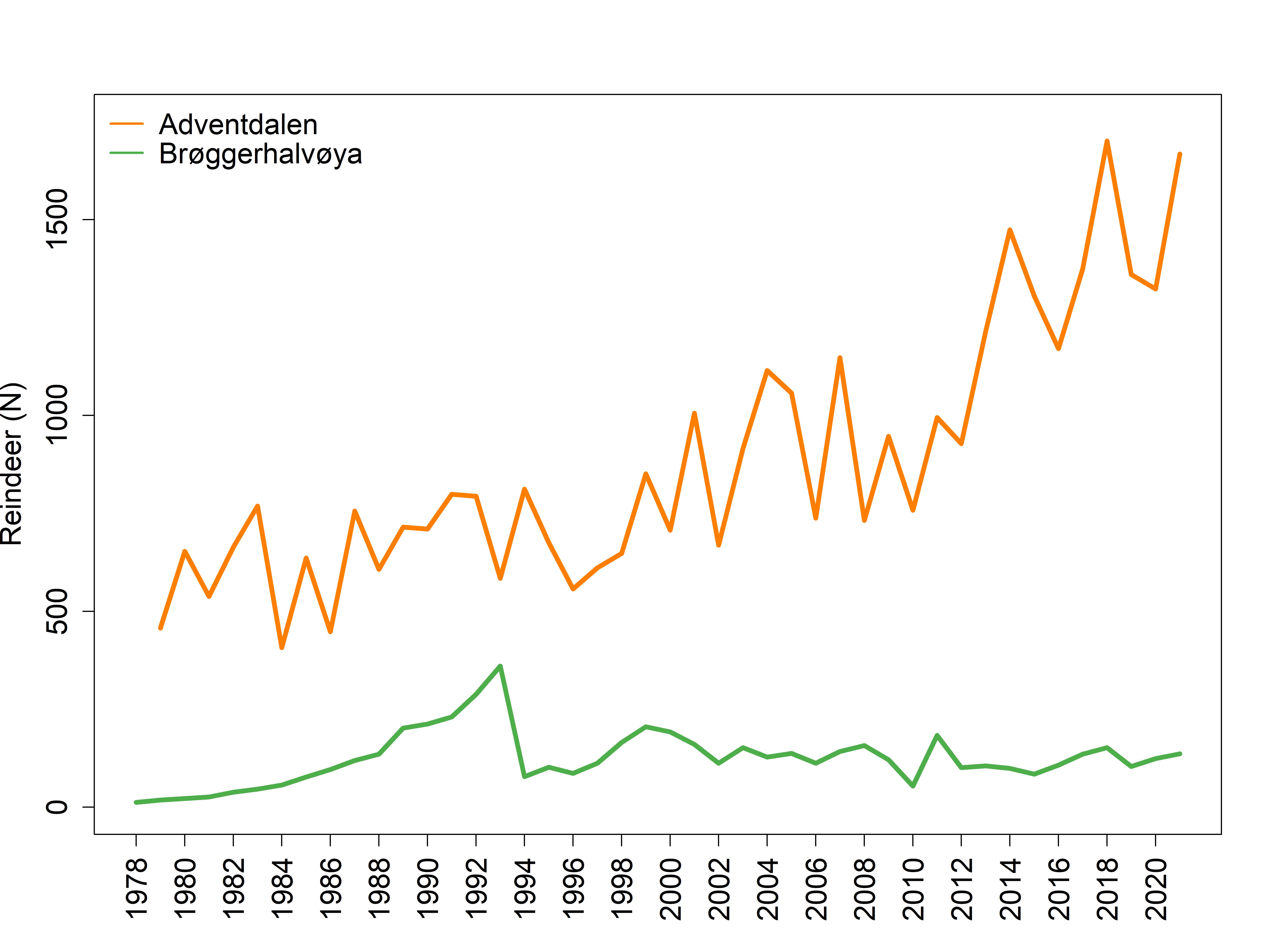The Svalbard reindeer (Rangifer tarandus platyrhynchus) is an endemic sub-species of reindeer that only exists on Svalbard. When the ancestors of the Svalbard reindeer arrived at the archipelago after the last glaciation is not known, but is estimated to be between 5-7000 years ago. However, substantial genetic differentiation from other reindeer populations in Eurasia, North-America and Greenland, suggest they have been isolated for a long time.
In the 19th century, the hunting pressure on Svalbard reindeer was increasing and several local populations were hunted to extinction. The hunting pressure increased further in the early 20th century, partly because the coal mining companies that established themselves on the archipelago, used professional hunters to provide reindeer meat for the workforce. Due to resulting low population sizes, the Svalbard reindeer became protected in 1925. By the 21st century the Svalbard reindeer has recolonised all areas where hunting had led to extinction. A strongly regulated legal hunt was opened for residents in the 1989 based on the principle that it should not have significant impact on local population sizes or demographic structure.
There are no efficient predators of reindeer on Svalbard. Competition from other herbivores is also limited, even though increasing goose populations may play a role in some habitats. The main drivers of Svalbard reindeer population dynamics is therefore food availability (density-dependence), climatic variability and possibly parasites. Climate is a main determinant of food availability as the above ground plant biomass production is strongly affected by summer weather conditions. Even though Svalbard is in the High-Arctic (74° – 81° N), the archipelago is exposed to an oceanic climate that may bring rain also in winter. Svalbard reindeer is sensitive to such mild winter climate as it can cause extensive icing on the tundra that reduce the reindeers’ access to vegetation substantially. In the 21st century, the monitored local populations of Svalbard reindeer have shown either a long-term increasing trend or little change in population sizes. However, climatic variability has caused substantial between year fluctuations in population sizes related due to variation in survival and reproduction.

Population abundance of Svalbard reindeer in the valley of Adventdalen (summer counts 1979-2021) and from the coastal Brøgger Peninsula (winter counts 1978-2021).
Expected climate impact
Climate change is expected to have both negative and positive effects on Svalbard reindeer. Warmer and wetter winters make episodes with rain in winter more common. Such events can cause ice on ground or in the snow pack, and reduce access to vegetation for foraging reindeer. At the same time, longer and warmer summers will improve plant growth and thereby improve forage availability for Svalbard reindeer. The balance between the negative effects of warmer winters and positive effects of warmer summers will determine the overall effect of climate change on Svalbard reindeer.
The climate change effects on Svalbard reindeer is expected to have cascading impacts on the generalist predator, the Arctic fox. Elevated abundances of reindeer and/or poor winter climate, may lead to more carrion available for the Arctic fox in winter and have a positive effect on their abundance. In addition, the Svalbard reindeer is an important herbivore on Svalbard and changes in its abundance may contribute to vegetation state changes.

Management relevance
- The Svalbard reindeer exist only in Svalbard. The management of the sub-species is therefore the responsibility of the Norwegian government alone.
- The Svalbard reindeer is a key species in the ecosystem on Svalbard and affect vegetation structure as well as Arctic fox population dynamics.
Monitoring methods
Local populations of Svalbard reindeer are monitored annually on Brøggerhalvøya, Sarsøyra, Kaffiøyra, in Adventdalen and in Reindalen-Colesdalen by structural counts (sex and age composition). In addition, individually marked reindeer are followed annually in capture-mark-recapture studies in the same monitoring areas where body mass, reproduction and survival are measured. From the animals shoot during the annual hunt, the hunters provide data on slaughter weights. In recent years, data on the spatial ecology of the Svalbard reindeer has been obtained from animals with GPS collars in the monitoring areas.